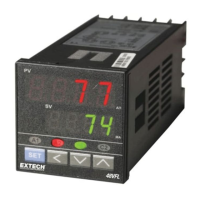6. Process Control
6.1 Connect the Inputs
The input types (thermocouple, RTD, analog) are hardware dependent. The part number
ordered, and the product label indicate the input type. If you are uncertain, please contact
Extech. Wire the input as described in the Wiring section.
6.2 Connect the Outputs
The output types (relay, dc trigger, analog) are hardware dependent. The part number
ordered, and the product label indicate the output type. If you are uncertain, please contact
Extech. Wire the output as described in the Wiring section.
6.3 Program the Controller
The programming menus contain critical settings that optimize the control of your process.
Success depends largely on configuring and tuning the controller correctly. Refer to the
Programming Menu sections for details.
6.4 Primary Relay Output Control
The primary control output is a mechanical, single-pole, single-throw, relay contact, and, by
definition, can only be in one of two states, ON or OFF (closed or open).
Control relays are wired in series with the control equipment (heater, pump, etc.) and require
AC or DC power to operate.
The ON-OFF and PID Time Proportioning control methods, explained below, apply to Relay
output control. The primary control output can be configured as a Heating (indirect acting) or
Cooling (direct acting) control type (see the ‘act’ parameter in Menu 4, Options).
6.5 Secondary (optional) Relay Output Control
The secondary control output is a mechanical, single-pole, single-throw, relay switch, and, by
definition, can only be in one of two states, ON or OFF.
Control relays are wired in series with the control equipment (cooler, pump, etc.) and require
AC or DC power to operate.
The ON-OFF and PID Time Proportioning control methods, explained below, apply to Relay
output control. The secondary control output is fixed at Cooling (Direct acting) control.
6.6 Pulsed DC Trigger Option
The optional DC Trigger supplies a 24V pulse and is an ON-OFF control type. See the Wiring
section for rear-terminal designations. The ON-OFF and PID Time Proportioning control
methods, explained below, apply to relay as well as DC Trigger control.

